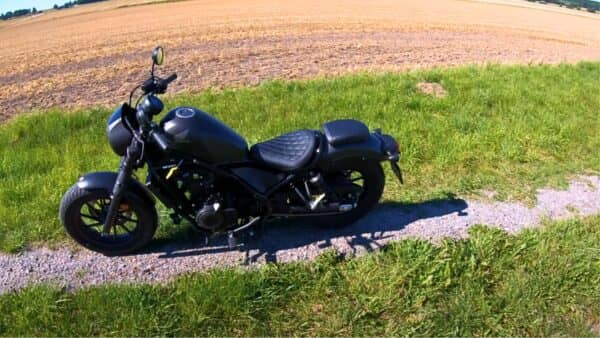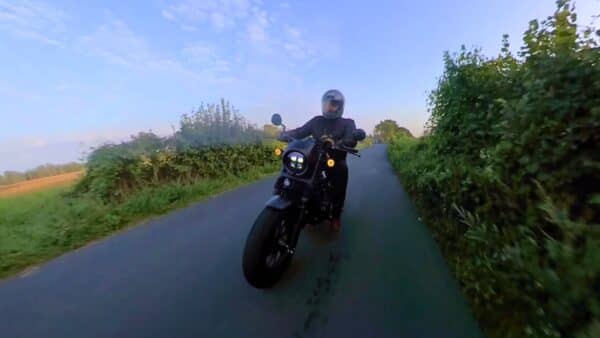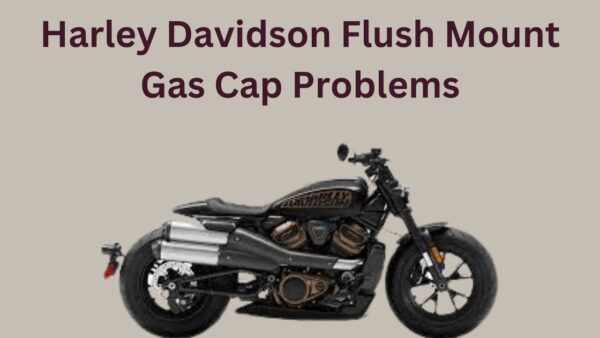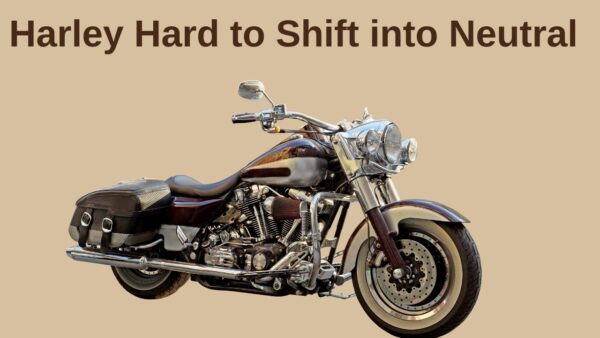The Honda Rebel 500, while a popular choice among motorcycle enthusiasts due to its mix of style and performance, isn’t without its share of issues.

In this article, we will discuss these common problems encountered by Honda Rebel 500 owners.
It also provides potential solutions and preventive measures to enhance your understanding and enjoyment of this motorbike.
Most Common Problems with Honda Rebel 500
One of the most common problems reported by riders is a discomforting seat, especially during long rides.

Another frequently noted issue is the absence of a fuel gauge, which can make fuel management a guessing game for riders.
Some owners have reported that the stock suspension setup is rather stiff and might not offer the smoothest ride over bumpy roads.
1. Gearbox Issue
The Rebel 500, while an excellent bike, has been known to have some issues with its gearbox.
This problem primarily results in a false neutral between gears, particularly between the 4th and 5th gear, which can lead to momentary loss of power.
The false neutral issue typically occurs when shifting gears at high RPMs.
Riders report that instead of smoothly transitioning from one gear to the other, the gearbox falls into a so-called ‘false neutral’ state, where the gear lever is stuck halfway between two gears.
To address this issue, you should ensure that you are executing firm and decisive gear changes.
Using your foot to firmly push up on the gear lever can help the gearbox fully engage with the next gear, helping to prevent false neutrals.
If the problem persists, it may be indicative of a more serious mechanical issue, such as worn gear dogs or a bent shift fork.
In this case, it’s advised that you consult with a professional mechanic for a thorough inspection and potential repair of the gearbox.
2. Coolant Leak
Coolant leak, if left unresolved, could potentially lead to engine overheating and significant damage.
The coolant is typically a bright green, pink, or yellow fluid, which gives it a distinctive appearance.
To address a coolant leak, first, ensure the motorcycle is cool to avoid burns from hot coolant or parts.
Begin by inspecting the radiator and hoses for visible signs of leakage, such as coolant residue or wet spots.
Pay close attention to the hose clamps and the seals around the water pump. If the leak source is not apparent, a pressure test could be conducted.
This test involves pumping air into the cooling system to increase pressure, making the leak easier to spot.
Once the leak source is identified, the next step is repair. For minor leaks from a hose or loose clamp, simply replacing the hose or tightening the clamp may suffice.
However, if the leak is coming from the radiator or water pump, it may require more intricate work or the replacement of parts.
3. Cramped legroom
One of the common issues experienced by riders is the cramped legroom.
This motorcycle, although an impressive machine, is not designed to cater to taller riders or those with longer legs.
The compact design, while beneficial in urban riding scenarios and beneficial for shorter riders, can lead to discomfort during longer rides if you need more space.
The foot peg position is a bit high, causing the knees to bend more than they would on other motorcycles, which can lead to muscle cramping and strain.
Related: Honda Shadow 660 Problems
However, the small space between the seat and footpegs can make it difficult to adjust your position during long journeys, significantly reducing overall comfort.
A potential solution to this problem could be to invest in aftermarket parts such as adjustable foot pegs or extended seat options.
These modifications can provide more legroom and improve the overall ride comfort.
4. No Oil Filter
One common issue users have experienced with the Rebel 500 is the absence of an oil filter.
An oil filter is a crucial component for the longevity and performance of your motorcycle.
It works by trapping harmful particles and contaminants that could damage the engine.
A lack of it in your motorcycle could cause the engine oil to circulate these particles, leading to potential engine damage or even failure.
To mitigate this, it’s suggested to install an aftermarket oil filter. Here is a guide on how to proceed:
Choose an oil filter compatible with the Honda Rebel 500. You can find a variety at your local motorcycle store or online. Ensure the one you pick is highly rated and durable.
To install, you’d typically need to drain the old oil, unscrew the old oil filter (if present), and screw in the new one.
However, since the Honda Rebel 500 doesn’t come with an oil filter, you’ll need an adapter plate to mount the filter.
Regularly check your oil filter for any signs of wear and tear. It’s generally recommended to change the oil filter every time you change your engine oil, usually every 3,000 to 5,000 miles.
5. Clutch Problems
One of the most common concerns reported by owners is with the clutch. The clutch feels heavy, especially for new riders, leading to hand fatigue over long distances.
In some cases, users have reported difficulty in smoothly shifting gears, which can largely be attributed to a stiff clutch.
If you’re facing this issue, adjusting the clutch lever’s free play can often result in a more manageable clutch.
This adjustment can be done by following these steps:
- The clutch adjuster is located on the clutch lever itself or on the clutch cable near the engine’s crankcase.
- Turn the adjuster in or out to change the amount of free play. The ideal free play for the Honda Rebel 500 is about 10-20mm.
- After adjusting, test the clutch for any improvement. It should now facilitate easier gear shifting and feel less stiff.
6. Starting Issues
This issue results when the motorcycle refuses to kick-start or if it takes multiple attempts to get it running.
There are several potential causes for this, including a drained or faulty battery, bad spark plugs, or a problematic starter motor.
To troubleshoot this issue, begin by checking the battery. Ensure it is fully charged and has a voltage reading of at least 12.6 volts.
If not, it might require charging or replacement. Next, examine the bike’s spark plugs.
If they’re blackened, wet, or eroded, it could mean they’re causing the problem and need replacement.
If the battery and spark plugs are in good condition, the next step is to inspect the starter motor.
This might be a bit complex and require a certain level of mechanical knowledge or professional assistance.
Listen for a clicking sound when you try to start the bike. If you hear this sound but the engine doesn’t start, it’s likely a starter motor issue.
7. Fuel Leaking From Carb
A common issue that some owners have encountered is fuel leakage from the carburetor. This problem typically arises due to a faulty carburetor float or a clogged needle valve.
The carburetor float controls the amount of fuel in the float bowl, and if it gets stuck or develops cracks, it can lead to an overfilling of the bowl, causing fuel leakage.
Similarly, a clogged needle valve can prevent the valve from closing, leading to an overflow of fuel.
To troubleshoot and fix this issue, follow these steps:
- Start by removing the carburetor from your Honda Rebel 500. Check the float for any visible damage or cracks. If it’s damaged, it needs to be replaced.
- The needle valve controls the flow of fuel into the float bowl. If it’s clogged or stuck, it could be causing the leak. Clean the valve thoroughly or replace it if necessary.
- In some cases, cleaning the carburetor can solve the issue. Use a carburetor cleaner to clean all parts and passages.
- Once you’ve made the necessary repairs or replacements, reassemble the carburetor and reinstall it. Start your bike and check for any signs of leakage.
8. Back Fender Issue
One common issue faced by several Rebel 500 owners relates to the back fender.
The problem arises due to the fender’s design, which leaves the rear wheel exposed, allowing road debris and water to splash onto the rider and back of the motorcycle.
To troubleshoot the issue, confirm that the problem lies with the back fender.
If you find yourself frequently splashed with water or debris, or the rear part of the bike gets dirty quickly, it’s likely the back fender is inadequate.
There are several aftermarket fenders available that provide improved coverage over the wheel. Look for one that fits the Rebel 500 model specifically.
Once you’ve selected a suitable fender, purchase it from a trusted supplier. Ensure it comes with the necessary hardware for installation.
Remove the existing fender as per the manufacturer’s instructions and install the new one.
If you do not have experience with motorcycle maintenance, consider hiring a professional to avoid damage to the bike.
Finally, take your bike for a ride in various conditions to ensure the new fender provides effective coverage and protection.
9. Buzzing Headlight
This problem typically arises due to the loose fit of the headlight assembly within its housing, which causes a noticeable buzzing sound, particularly at higher speeds.
To troubleshoot the issue remove the screws securing the headlight to its bracket.
Be careful not to misplace these screws, as you will need them to reinstall the headlight.
Once the headlight is free, check the fit of the assembly within the housing. If it’s loose, this is likely the source of the buzzing sound.
To eliminate the buzzing, add some foam padding or rubber washers between the headlight assembly and the housing. This will provide a tighter fit and reduce vibration.
After you’ve added the padding, reinstall the headlight in its bracket. Make sure the screws are tight, but not overly so, to avoid damaging the assembly or housing.
Finally, take a test ride to ensure the buzzing sound has been eliminated. If still present, you may need to add more padding or ensure everything is securely fitted.

Ahtsham Younas is a passionate blogger and content writer. He loves to ride motorcycles and learn the mechanical process behind the motorcycles.
He has been writing articles in the motorcycle industry since 2019 and has learned many things about motorbike niches.


